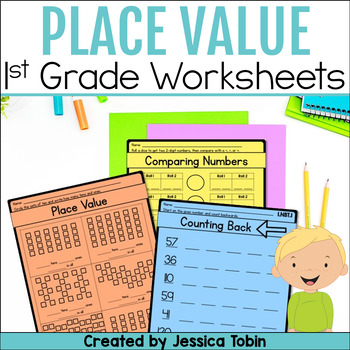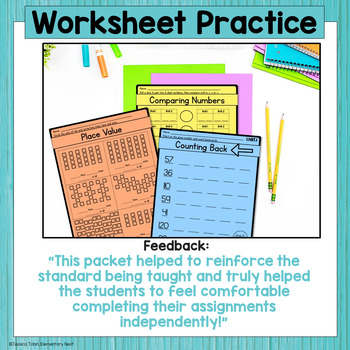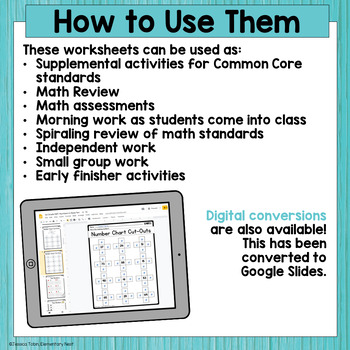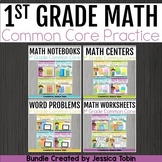Place Value Worksheets 1st Grade Math Review, Tens and Ones, Comparing Numbers
- PDF
- Google Apps™
- Easel Activity

What educators are saying
Also included in
- This 1st grade math worksheets bundle pack is a no-prep resource to use when teaching or reviewing Common Core 1st grade math standards. With worksheets for topics on geometry, measurement and data, place value, and addition and subtraction, this covers your year. This is not a curriculum, but a resPrice $19.00Original Price $24.00Save $5.00
- This is a common core aligned math bundle for 1st grade. There are four bundles included: worksheets, centers, short answer or word problems, and interactive notebook templates. Each packet included standard-specific activities. There are centers, printables, short answer, and interactive notebook tPrice $64.00Original Price $91.00Save $27.00
Description
Are you looking for place value worksheets to help your 1st grade math students? Use these worksheets as practice, review, or assessments! This set of Common Core standards-based math worksheets are aligned to the NBT, or Numbers and Operations in Base Ten, domain.
These NBT worksheets are a no-prep resource to use when teaching numbers and operations in base-ten! This is not a curriculum, but a resource to help supplement your lessons! With worksheets for topics such as numbers to 120, teen numbers, understanding tens and ones, comparing two-digit numbers, adding double digit numbers to 100, ten more and ten less mental math, and subtracting tens. The unit comes with answer keys too!
This item aligns with the Common Core standards for the Numbers in Base-Ten domain, but you don't have to be in a Common Core classroom to use this pack!
Place Value and Base-Ten Topics Covered:
- Writing to 120
- Counting to 120
- 120 Charts
- Teen Numbers
- Place Values Tens and Ones
- Comparing 2-Digit Numbers
- Adding 2-Digit to 1-Digit Numbers
- Adding 2-Digit Numbers to Decade Numbers
- Adding 2-Digit Numbers to 100
- Mental Math (10 More, 10 Less)
- Subtracting Multiples of Ten
There is also a link to the worksheets that have been digitally converted in Google Slides within the PDF.
This item is included in a money-saving printables bundle.
- Click here for the worksheets bundle.
You can save even more money when buying this item in a first grade common core bundle, which includes the printables bundle, plus short answer, centers, and interactive notebook templates.
- Click here for the MEGA bundle.
This purchase is for one single classroom only.
If you're interested in sharing with other classrooms, make sure to buy the extra licenses for a discount through the TeachersPayTeachers tool. If you are interested in a site license, please contact me for a quote at jessica.L.tobin@gmail.com.
Common Core Math Standards:
- CCSS.Math.Content.1.NBT.A.1 (1.NBT.1)- Count to 120, starting at any number less than 120. In this range, read and write numerals and represent a number of objects with a written numeral.
- CCSS.Math.Content.1.NBT.B.2 (1.NBT.2)- Understand that the two digits of a two-digit number represent amounts of tens and ones. Understand the following as special cases:
- CCSS.Math.Content.1.NBT.B.2.a- 10 can be thought of as a bundle of ten ones — called a "ten."
- CCSS.Math.Content.1.NBT.B.2.b- The numbers from 11 to 19 are composed of a ten and one, two, three, four, five, six, seven, eight, or nine ones.
- CCSS.Math.Content.1.NBT.B.2.c- The numbers 10, 20, 30, 40, 50, 60, 70, 80, 90 refer to one, two, three, four, five, six, seven, eight, or nine tens (and 0 ones).
- CCSS.Math.Content.1.NBT.B.3 (1.NBT.3)- Compare two two-digit numbers based on meanings of the tens and ones digits, recording the results of comparisons with the symbols >, =, and <.
- CCSS.Math.Content.1.NBT.C.4 (1.NBT.4)- Add within 100, including adding a two-digit number and a one-digit number, and adding a two-digit number and a multiple of 10, using concrete models or drawings and strategies based on place value, properties of operations, and/or the relationship between addition and subtraction; relate the strategy to a written method and explain the reasoning used. Understand that in adding two-digit numbers, one adds tens and tens, ones and ones; and sometimes it is necessary to compose a ten.
- CCSS.Math.Content.1.NBT.C.5 (1.NBT.5)- Given a two-digit number, mentally find 10 more or 10 less than the number, without having to count; explain the reasoning used.
- CCSS.Math.Content.1.NBT.C.6 (1.NBT.6)- Subtract multiples of 10 in the range 10-90 from multiples of 10 in the range 10-90 (positive or zero differences), using concrete models or drawings and strategies based on place value, properties of operations, and/or the relationship between addition and subtraction; relate the strategy to a written method and explain the reasoning used.








